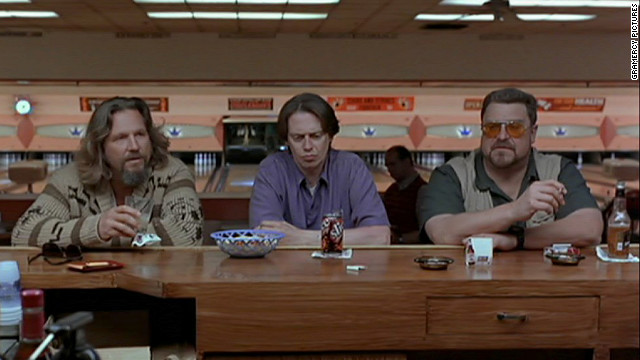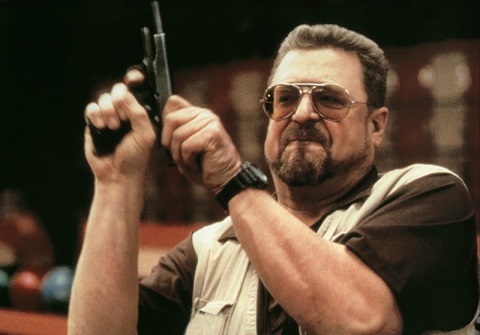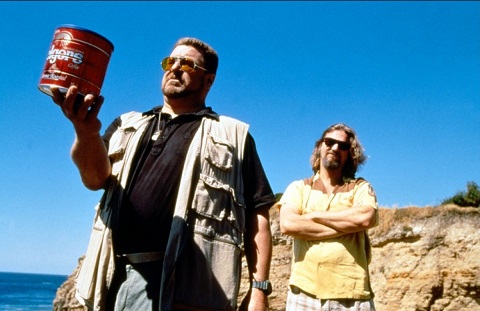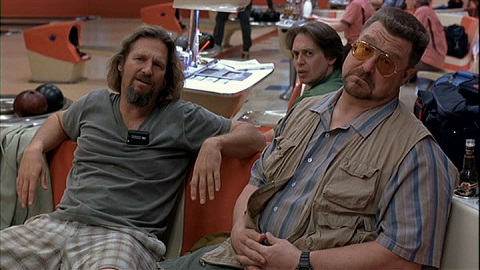
THE BIG LEBOWSKI. To watch it once is sublime. To watch it twenty times is sublime twenty times. To watch it with a full crowd is probably about as much fun as is legally possible within city limits. I’ve seen it with small groups many times, but I’ve only actually seen it with a crowd once, back in 1998 when it was first released. As the credits rolled, my buddy and I turned to each other and both said simultaneously, “I could’ve watched that all day.” As far as I know there is no twenty-four-hour cut of the film, but I have certainly seen it as many times, and the rest of the world has gradually since come to share in our enlightenment. In the intervening years since its theatrical release, the Lebowski legend has only grown, and pretty much everyone with a brain and a soul and a sense of humor is in agreement.

It’s actually really hard to write about THE BIG LEBOWSKI because it’s such well-trod turf and because it’s such an individualistic piece of work that its primary charms are in watching it, not having it described to you. Of course, if you know your film history, you know that THE BIG LEBOWSKI didn’t spring up out of nowhere — it’s a fairly direct takeoff of Howard Hawks’ THE BIG SLEEP, starring Humphrey Bogart and Lauren Bacall (who happens to be a distant relative of yours truly, for the record, which made that episode of The Sopranos a tough watch). I was lucky enough in 1998 to have just chanced to watch THE BIG SLEEP for the first time about a week before I saw THE BIG LEBOWSKI for the first time. I can’t possibly understate how much funnier THE BIG LEBOWSKI is when you’re in on the joke: The pointed difference between 1940s Los Angeles and 1990s Los Angeles, the jazzy past versus the country-Western present, the labyrinthine mystery plot that one suspects even the screenwriters couldn’t decipher (and which, in THE BIG LEBOWSKI at least, is treated as almost an afterthought), and most of all. Jackie Treehorn’s dick drawing.

In THE BIG SLEEP, Humphrey Bogart tries to get a vital clue from running a pencil over the indentations of a notepad. In THE BIG LEBOWSKI, Jeff Bridges attempts the same trick, only to find that his adversary has been idly doodling penises while on the phone. That joke is incredibly hilarious on its own, but once you realize that it’s a spoof of a deadly-serious source, it becomes transcendently funny.

The Coens’ brilliant inspiration was to take a Chandleresque noir set-up, and then drop two amazing and ridiculous characters into it to see how they’d handle things. First there’s Jeff Bridges as The Dude, about which plenty has been written and said but not as often the fact that the character is based off a real person the Coens know. This was a turning point in a great Hollywood career, where Bridges definitively transitioned from strikingly-handsome leading-man type to full-on growly and beardy character actor. He was wonderful as a leading man (STARMAN, FEARLESS) but the world needed the TRUE GRIT Jeff Bridges too, and that’s where he arrived.

And then there’s John Goodman as the bellowing and verbose (and bellicose!) gun nut Walter, who again is a stroke of genius even if youdon’t know that he is playing a real person with very little exaggeration. John Milius is a writer and filmmaker who was an early confederate of Steven Spielberg and the 1970s film-school generation, who had a hand in the writing of the Indianapolis speech in JAWS and in one of the DIRTY HARRY sequels, and who made the vastly misunderstood and thoroughly awesome 1982 adaptation of the Conan The Barbarian pulp stories. If you’ve ever listened to the incredible DVD commentary for CONAN THE BARBARIAN, you’d know that what John Goodman is actually doing in THE BIG LEBOWSKI is a pitch-perfect John Milius impersonation.

Like I say, THE BIG LEBOWSKI is funny enough without knowing these little factlets, but it becomes a new level of comedic achievement when seen in that light. Another great joke of THE BIG LEBOWSKI is that for a movie about confused bowlers of conflicting political ideologies solving mysteries, it is as impeccably crafted as any prestige picture. The photography by cinematic titan Roger Deakins is typically beautiful, the editing by Tricia Cooke and the legendary Roderick Jaynes is crisp and sharp. Just think back on those elaborately-choreographed and inventive Busby Berkeley dream-sequence numbers. This isn’t lazy filmmaking by any stretch. It’s as smart and as artistic as any so-called “Best Picture.” For a meandering comedy classic, this is a phenomenally well-made film.

The Coens are such an interesting case. They work in two distinct modes: madcap and noir. The first mode is exemplified by their comedies, a la RAISING ARIZONA, THE HUDSUCKER PROXY, and the more recent BURN AFTER READING. The second mode is the MILLER’S CROSSING mode, which probably starts with BLOOD SIMPLE, factoring in their obvious love for crime cinema and pulp literature, and dates all the way forward to their 2007 triumph NO COUNTRY FOR OLD MEN and 2010’s TRUE GRIT. (There’s actually a third, far more esoteric and personal mode, which includes movies like BARTON FINK, A SERIOUS MAN, and 2013’s INSIDE LLEWYN DAVIS, but that’s a subject for another day).
THE BIG LEBOWSKI comes down strongest on the side of comedy, though it’s an intriguing blend of madcap and noir. The stakes, as far as The Dude and Walter know, are real: A young woman could be killed if they don’t deliver a ransom. But the fact that these two guys are the world’s least-qualified messengers, who spend their private-dick downtime at the bowling alley, is what makes the movie so fresh and so funny.

For having said up front that THE BIG LEBOWSKI is hard to write about, I sure have found plenty of words. I guess it IS fun to write about. But I’d still rather go watch it again.

New Yorkers can see THE BIG LEBOWSKI tonight, at midnight, at the Landmark Sunshine Cinema.
@jonnyabomb

- [THE BIG QUESTION] WHAT’S YOUR FAVORITE FEMALE ENSEMBLE IN MOVIES? - July 22, 2016
- [IN THEATERS NOW] THE BOY (2016) - January 24, 2016
- Cult Movie Mania Releases Lucio Fulci Limited Edition VHS Sets - January 5, 2016
Tags: Ben Gazzara, bowling, Busby Berkeley, Carter Burwell, comedy, ethan coen, Howard Hawks, Humphrey Bogart, Jeff Bridges, joel coen, John Goodman, John Milius, John Turturro, Jon Abrams, Julianne Moore, Lauren Bacall, Los Angeles, Noir, Peter Stormare, Philip Seymour Hoffman, Raymond Chandler, Roderick Jaynes, Roger Deakins, Sam Elliott, Steve Buscemi, Tara Reid, Tricia Cooke






No Comments